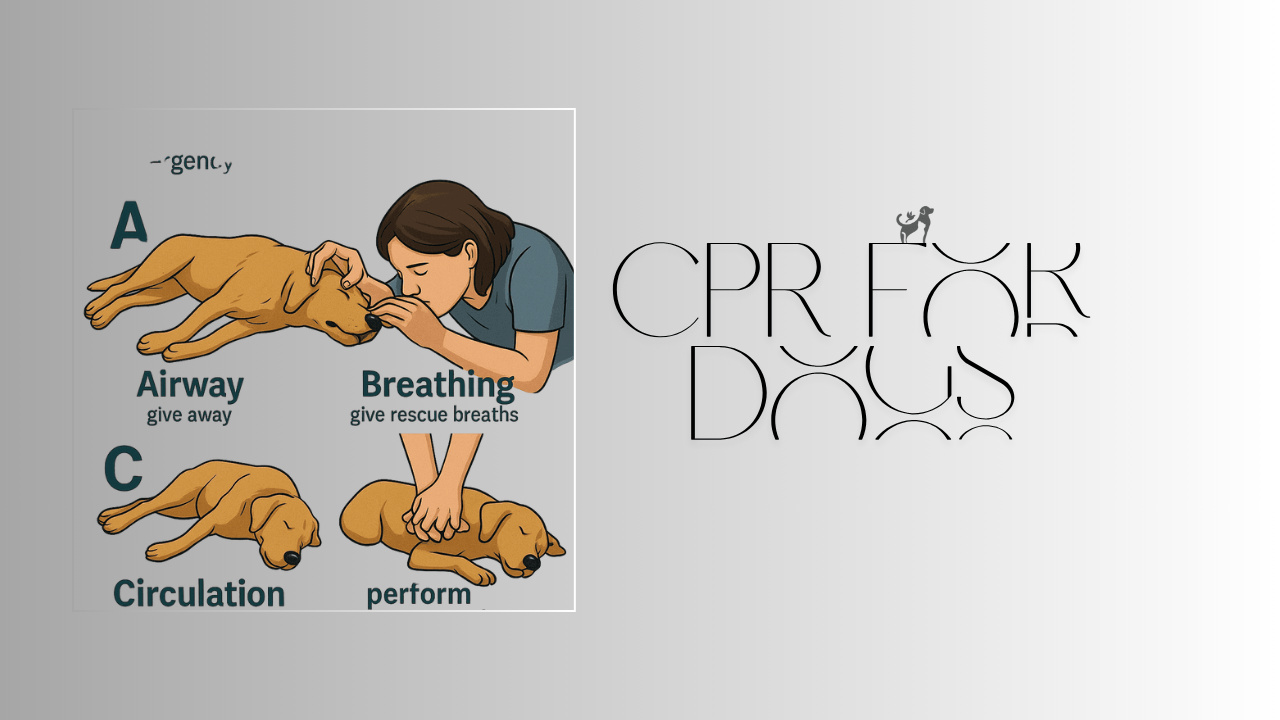CPR for dogs is something many pet owners hope they’ll never need, but knowing how to perform it can mean the difference between life and death. Emergencies can happen unexpectedly — choking, drowning, or cardiac arrest — and immediate action is crucial. This guide will walk you through the essential steps of canine CPR, tips for preparation, and why every dog parent should feel empowered to act fast.

What Is Dog CPR?
Cardiopulmonary resuscitation (CPR) for dogs is an emergency procedure that combines chest compressions with artificial respiration. It’s designed to manually preserve brain function and blood circulation when the heart or breathing has stopped.
Most pet owners don’t realize how important CPR knowledge can be until they face an emergency. Like human CPR, the technique involves ensuring an open airway, delivering breaths, and compressing the chest to keep oxygen moving.
When Do Dogs Need CPR?
Some common scenarios where dog CPR may be needed include:
- Drowning incidents
- Choking on food or toys
- Cardiac arrest from trauma or illness
- Electric shock
- Severe allergic reactions
- Heatstroke or hypothermia
If your dog collapses, isn’t breathing, or has no detectable heartbeat, you should immediately begin CPR and contact your veterinarian.
Step-by-Step CPR for Dogs
1. Assess Responsiveness
Call your dog’s name. Tap gently and check for signs of movement. If unresponsive, act quickly.
2. Check Airway
Open the mouth and look for obstructions. Remove any visible debris but avoid pushing objects further down.
3. Check Breathing and Pulse
Watch for chest movement. Feel for breath through the nose. Check the femoral artery (inner thigh) for a pulse.
4. Begin Chest Compressions
- Place your dog on their right side.
- For medium and large dogs: Use both hands over the widest part of the chest.
- For small dogs and puppies: Use one hand or your fingers depending on size.
Compression rate: 100–120 per minute.
Compression depth: About 1/3 the width of the chest.
5. Provide Rescue Breaths
After every 30 compressions, give 2 breaths:
- Close the mouth and extend the neck.
- Seal your mouth over the nose and exhale until the chest rises.
Repeat cycles of 30 compressions and 2 breaths for two minutes, then check for breathing or a pulse.
6. Continue Until Help Arrives
Keep going until:
- Your dog starts breathing or moving.
- A vet or emergency responder takes over.
Differences by Dog Size
Small Dogs (under 30 lbs):
- Use gentler compressions.
- Consider compressing directly over the heart.
Medium Dogs (30–60 lbs):
- Compress the widest part of the chest.
Large Dogs (60+ lbs):
- Use more force, keeping arms straight and using your body weight.
How to Check for Breathing and Pulse
- Breathing: Look for chest movement, listen at the nose.
- Pulse: Feel the femoral artery inside the back leg. No pulse? Begin compressions.
If you’re unsure, start CPR anyway. As PetMD notes, incorrect action is better than inaction in a crisis.
Common Mistakes to Avoid
- Delaying action: Every second counts.
- Skipping rescue breaths: Both compressions and breaths are essential.
- Too deep/too shallow compressions: Match the depth to your dog’s size.
- Failing to get vet care immediately: CPR is a stopgap, not a substitute.
Training and Certification Options
Want to feel more confident? Pet CPR courses are available in person and online. The American Red Cross offers a pet first aid and CPR program that’s widely respected.
Learning from a professional ensures you’re ready to act calmly and effectively.
Preventative Safety Tips
- Supervise pets around water.
- Avoid leaving small toys unattended.
- Learn choking signs.
- Keep a pet first aid kit and vet contacts ready.
- Train your dog in basic obedience to reduce accident risks.
Explore more safety and wellness tips at fluffze.com.
FAQ
Can you really do CPR on a dog?
Yes, and it can save a life when done properly. It’s especially useful in choking, trauma, or cardiac cases.
Is dog CPR the same as human CPR?
The principles are similar, but techniques differ based on size and anatomy. Don’t use mouth-to-mouth unless trained.
How long can a dog survive without oxygen?
Brain damage may occur within 4–6 minutes, so start CPR immediately if there’s no breathing.
Should I practice CPR on my dog?
No. Practice on a dummy or attend certified training. Improper compressions can injure a healthy dog.
Is CPR safe for older dogs?
If a dog is unconscious and not breathing, CPR is necessary regardless of age. Use gentle compressions if frail.
Final Thoughts
Knowing how to perform CPR for dogs could be the most important skill you never thought you’d need. Emergencies happen fast, and acting calmly can save your pet’s life. With training, preparation, and a confident mindset, you can be your dog’s first responder when it matters most.
Be ready, stay calm, and consider signing up for a pet CPR course to prepare for the unexpected.
Call-to-Action
Was this guide helpful? Share it with other pet parents so they can be prepared too. And for more lifesaving pet care advice, visit fluffze.com today.
Written by Author Box
Written by Shawn, pet lover & contributor at Fluffze
Related Articles:
Smart Cat Dental Care at Home: Keep Your Cat’s Smile Healthy
Behavioral Training vs Obedience Training
Traveling to Europe with a Cat: The Ultimate Guide
How to Train a Dog to Use a Litter Box: Simple Steps
Scottish Fold Lifespan: How Long Do They Live?
Crate Training Mistakes to Avoid: Setting Your Dog Up for Success





